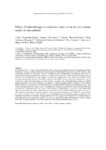Effect of balneotherapy in sulfurous water on an in vivo murine model of osteoarthritis

Ver/Abrir
Use este enlace para citar
http://hdl.handle.net/2183/25631Colecciones
- Investigación (FCS) [1293]
Metadatos
Mostrar el registro completo del ítemTítulo
Effect of balneotherapy in sulfurous water on an in vivo murine model of osteoarthritisAutor(es)
Fecha
2019-11-01Cita bibliográfica
Vaamonde-García C, Vela-Anero Á, Hermida-Gómez T, Fernández-Burguera E, Filgueira-Fernández P, Goyanes N, Blanco FJ, Meijide-Faílde R. Effect of balneotherapy in sulfurous water on an in vivo murine model of osteoarthritis. Int J Biometeorol. 2020 Mar;64(3):307-318.
Resumen
[Abstract] Osteoarthritis (OA) is a chronic joint disease that results in progressive cartilage destruction and subsequently joint dysfunction. Growing evidence indicates beneficial impact of balneological interventions in OA; however, their mechanisms of action are still unclear. Here, we evaluate the effect of balneotherapy in sulfurous water in an OA experimental model. Experimental OA was induced in Wistar rats by transection of the medial collateral ligament and removal of the medial meniscus of the left knee. Animals were randomized into three groups: non-treated (control) and balneotherapy using sulfurous water (SW) or tap water (TW). Macroscopic evaluation was performed, as well as evaluation of pain levels and analysis of motor function by rotarod test. Histopathological changes in articular cartilage and synovium were also evaluated. The presence of matrix metalloproteinase-13 (MMP-13) and oxidative damage markers was assessed by immunohistochemistry. Joint destabilization induced joint thickening, loss of joint flexion, and increased levels of pain. At day 40, animals from SW group presented lower pain levels than those from control group. Experimental OA also affected motor function. Balneotherapy in sulfur-rich water significantly improved joint mobility in relation to that in tap water. Besides, we observed that cartilage deterioration was lower in SW group than in the other two groups. Likewise, SW group showed reduced levels of MMP-13 in the cartilage. Conversely, we failed to observe any modulation on synovial inflammation. Finally, balneotherapy in sulfurous water diminished the presence of oxidative damage markers. Our results suggest the beneficial effect of balneotherapy in sulfur-rich water on an experimental model of OA, showing a reduced cartilage destruction and oxidative damage. Thus, these findings support the use of balneotherapy as a non-pharmacological treatment in OA.
Palabras clave
Balneotherapy
Cartilage
Hydrogen sulfide
Osteoarthritis
Oxidative damage
Cartilage
Hydrogen sulfide
Osteoarthritis
Oxidative damage
Versión del editor
Derechos
The final publication is avaliable at Springer Link
ISSN
0020-7128





